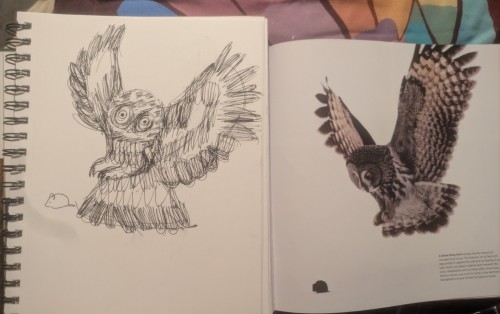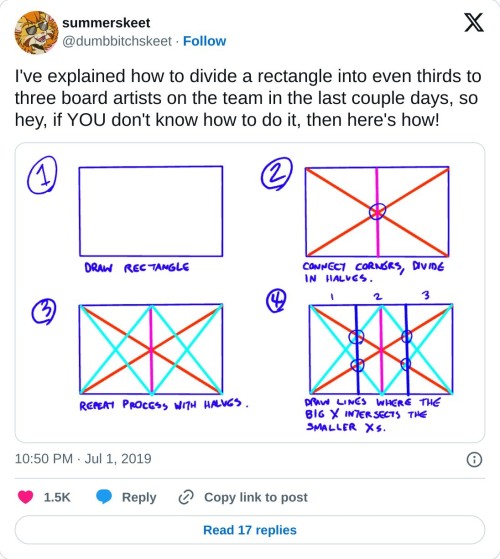Art Advice - Blog Posts
Idk who needs to hear that, but using a shit ton of references for art is valid. Tracing, as long as you credit the person if it's very identical and if you post it, is valid. You learn by doing. So if you trace something enough, you'll eventually be able to draw the previously traced piece from memory, and you can adapt it to whatever you want. Be it a different style, a different pose, a different palette.. Same with references.. That's what they're for, people. Tracing isn't illegal, neither is using references, no matter how cheap that feels.
That's just how we learn. So, would you rather be stuck and eventually give up because you can't get it right? Or will you seek help by the very tools given to artists so they can learn these things?
It's literally in the Sesame Street opening.. Not sure if it's in the English version, but a german verse in there was always "Sometimes you have to ask to understand these things!". So ask. Ask google, ask people around you who draw, ask Google for references, ask. Just ask, guys
Advice: The mouth is a bit too low, and most characters don't have anything in the nose spot in HS (I still think the nose(?) though!)
The rest is pretty much perfect tho👍
Um... I think I took a wrong turn somewhere.

If anyone has any idea how to get back, that would be greatly appreciated.
Well said, and this is some great advice to pass on. 👏
How fucking annoying is it when you feel so restless with creative energy but you can’t decide what to do with it and when you finally try to create something it comes out shit so you just give up and sit there being all creatively annoyed and jittery.

I got two books from the Library. One on birds and another on frogs. I am trying to draw at least one critter from one book a day :) It helps me when I'm having trouble feeling inspired and gives me an immediate reference image to learn from. Less pressure cus I'm not super invested in the idea either. Highly recommend :D Super fun! VISIT YOUR LOCAL LIBRARY, RAHHH (or I'll fkin get u like this owl)








disclaimer: I am east asian. if anyone who is not white sees anything wrong with my phrasing, inaccuracies, or insensitivity, or something I missed, please feel free to add on. I'm just one person with one perspective; none of what I say should be taken as The Singular way to draw an Asian character. if you havent done so already, please take the effort to expand your view of Asian culture outside this one tutorial.
if a white person reblogs this and adds something stupid I'm going to bite and kick you like a wild animal
Know what I’m salty about?
In all my art classes, I was never taught HOW to use the various tools of art.
Like yes, form, and shape and space and color theory and figure drawing is important, but so is KNOWING what different tools do.
I’m 29 and I JUST learned this past month that India Ink is fucking waterproof when it dries. Why is this important? Because I can line something in India Ink and then go over it with watercolors. And that has CHANGED the ENTIRE way I art and the ease I can create with.
tldr: Art Teachers: teach your students what different tools do. PLEASE.

really helpful technique ^ once you know how to divide by halves and thirds it makes drawing evenly spaced things in perspective waaay easier:


art block, writer’s block, “art funk”, “burnout”, yada yada… it’s all the same thing, being a creator and wanting to create but having some kind of a wall preventing you from doing this.
this wall can take a lot of different forms, and i’m going to approach this post from the perspective of a visual artist, but no matter the medium, we all have a skill we’ve trained ourselves in and what I’m talking about will apply regardless.
Anyway as I said there’s a few different forms this wall can take. Here’s a few of them that I can think of:
Disillusionment with your current skill level
A loss of direction
Fatigue
Lack of drive
It’s really important to identify exactly what your wall is if you want to be able to dismantle it. This isn’t every way it can manifest either, just the most common ways that I see it manifesting, and you might have multiple at once!
Take some time to really self reflect on what the problem is if none of these are resonating after you’ve read the post, whatever it is you can find a way to manage it.
The most common advice I see for “defeating [creator’s] block” is committing to spending like five minutes a day working on something, anything at all. And that’s good advice! but not really for creator’s block, I think.
It’s GREAT advice if you’re lacking in discipline though, like I can easily get distracted and not work on things for months. So committing to work on comic related things for at least 30 minutes a day (and having this commitment be to other people that I’m checking in with each day, i think thats an important part) has worked really well for me, personally.
But I wasn’t dealing with any kind of a block, I just lacked discipline. I don’t think it’s very useful if for example, you hate how your art looks so you don’t want to draw anything anymore lmao
With that in mind, lets go through that list and I’ll try give you some advice from my experiences, and hopefully it’ll help give you the means to identify the problems you’re struggling with and find solutions to them if my advice isn’t quite what you need.
—
1. Disillusionment with your current skill level
So! it’s time to pull out everyone’s favourite graphic! this version was created by shattered-earth on deviantart, though the original is by Marc Dalessio

obviously this says art, but again this is applicable to all mediums. It’s an important concept to understand, the idea of a creator’s high vs a creator’s low depending on how developed your critical eye has become compared to your skill level.
If you’re not aware of it and don’t understand what’s happening, it’s REALLY easy to lose all motivation to create anything. Because why bother, if everything sucks? Definitely one of the most dangerous blocks you can run into, I think.
The solution, as with all of these walls, is to be kind to yourself.
Your critical eye improving is emotionally taxing, but it’s also an opportunity for great growth! It’s not easy, though. To get through it, you have to really confront what you don’t like about your work and target your weaknesses, and then you have to put in the time to try and improve them. That’s tough.
But self study doesn’t have to be a solo activity. Talk with your friends, seek out communities of creators, and follow resource blogs, channels, etc. I really think the best thing you can do is surround yourself with other creators, I’m in a few discords and hang out in the creative section of various forums etc
But this is really important: The act of targetting your weaknesses in order to improve them is going to make it REALLY easy for you to lose track of what you like about your work, and can in fact compound the issue and make you only focus on your flaws.
So, be kind to yourself. If you’re not happy with what you create, take the time to critically analyse your work. What don’t you like? What do you like? Don’t lose track of what you like while you study the things you’re less confident about, and with some patience and work your skill will catch up with your eye again.
I really can’t emphasise enough how important it is to not lose track of what it is you like about your work. The biggest motivation killer is always going to be falling out of love with your work, so do everything you can to prevent yourself losing the joy of creating.
Like, sure, a work might be technically perfect, but did you enjoy yourself while creating it? If you always ensure the answer to that is yes, the mismatch between your critical eye and your skills will be easier to handle because at least you’re still enjoying yourself, you know?
Keep reading
Hi! I just found your art and it’s so beautiful, I just have two questions- where do you find your pose references (do you take them yourself or look somewhere online)? And how do you paint lighting so well, especially on faces? Thank you and I hope you have a nice day ❤️
Hi there! I do both, I take pictures of stuff like my hands, poses, etc. and I also look online to find similar poses to get as many angles as I can.
For painting lighting, I look at photo references of lighting where it’s close to what I’m painting. Stuff like the turning shadow, rebound light, cast shadow; see if you can identify those in references or other objects. I’d also look at Bargue plates (ex down below), especially for faces. Lighting on faces is a bit more complex because there are so many planes at different angles, but hey, that’s what makes it interesting too. It definitely helps to look at facial structure drawings and sculptures. Knowing where the planes of the face are is important when you’re painting light on faces.


I love Bargue :)
I have a quick question about colouring if you dont mind! 🥺 I notice that whenever I try to render something with lots of shades and colours etc (esp if there’s dramatical lighting) everything ends up looking just,, muddy? I was wondering if that’s something you had to deal with before and if you have any advice on how to fix it? Haha thank you!!!
This definitely happened to me in my earlier years, and it sometimes still happens now if I’m not paying attention.
If something’s turning out to be muddy, I would try more clearly defining your contrasts in the image. Especially with dramatic lighting, it should be relatively simple (though not easy) to portray contrast, as opposed to something like more softer lighting/not as contrasting. Definitely check out your values (just lower saturation of the whole image till it’s in greyscale to check) from time to time while painting if you feel your image is getting muddy. Usually that’s a result of things like overrendering, not enough contrast (and contrast can come from both hue and value, not just value). So keep in mind color theory along with value, since color can definitely be a factor in muddiness. For ex, contrast in terms of color theory can be a complementary color scheme, and contrast in value is light and dark, and the intensity and degree to which you apply those is up to you :)
I also recommend simplifying your lights and darks at first, so you know where those are placed and so you don’t accidentally let them get away from you while painting. And use references too!! See how other artists paint light and dark, for example. Another tip is to paint the planes of an object before softening them, and to see if the contrast is as you wanted it to be. Think low-res polygon going to a more rounded form. Good luck! Happy painting :)